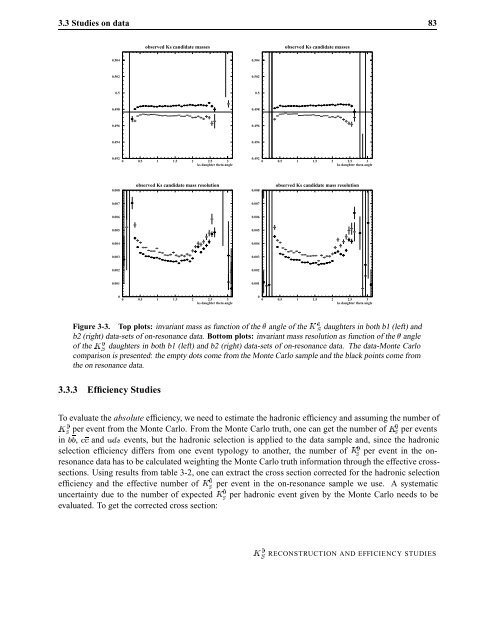Violation in Mixing
Violation in Mixing
Violation in Mixing
Create successful ePaper yourself
Turn your PDF publications into a flip-book with our unique Google optimized e-Paper software.
3.3 Studies on data 83<br />
0.504<br />
0.502<br />
0.5<br />
0.498<br />
0.496<br />
0.494<br />
observed Ks candidate masses<br />
0.492<br />
0 0.5 1 1.5 2 2.5 3<br />
ks daughter theta angle<br />
0.008<br />
0.007<br />
0.006<br />
0.005<br />
0.004<br />
0.003<br />
0.002<br />
0.001<br />
observed Ks candidate mass resolution<br />
0<br />
0 0.5 1 1.5 2 2.5 3<br />
ks daughter theta angle<br />
0.504<br />
0.502<br />
0.5<br />
0.498<br />
0.496<br />
0.494<br />
observed Ks candidate masses<br />
0.492<br />
0 0.5 1 1.5 2 2.5 3<br />
ks daughter theta angle<br />
0.008<br />
0.007<br />
0.006<br />
0.005<br />
0.004<br />
0.003<br />
0.002<br />
0.001<br />
observed Ks candidate mass resolution<br />
0<br />
0 0.5 1 1.5 2 2.5 3<br />
ks daughter theta angle<br />
Figure 3-3. Top plots: <strong>in</strong>variant mass as function of the � angle of the Ã Ë daughters <strong>in</strong> both b1 (left) and<br />
b2 (right) data-sets of on-resonance data. Bottom plots: <strong>in</strong>variant mass resolution as function of the � angle<br />
of the Ã Ë daughters <strong>in</strong> both b1 (left) and b2 (right) data-sets of on-resonance data. The data-Monte Carlo<br />
comparison is presented: the empty dots come from the Monte Carlo sample and the black po<strong>in</strong>ts come from<br />
the on resonance data.<br />
3.3.3 Efficiency Studies<br />
To evaluate the absolute efficiency, we need to estimate the hadronic efficiency and assum<strong>in</strong>g the number of<br />
Ã Ë per event from the Monte Carlo. From the Monte Carlo truth, one can get the number of Ã Ë per events<br />
<strong>in</strong> ��, and Ù�× events, but the hadronic selection is applied to the data sample and, s<strong>in</strong>ce the hadronic<br />
selection efficiency differs from one event typology to another, the number of Ã Ë per event <strong>in</strong> the onresonance<br />
data has to be calculated weight<strong>in</strong>g the Monte Carlo truth <strong>in</strong>formation through the effective crosssections.<br />
Us<strong>in</strong>g results from table 3-2, one can extract the cross section corrected for the hadronic selection<br />
efficiency and the effective number of Ã Ë per event <strong>in</strong> the on-resonance sample we use. A systematic<br />
uncerta<strong>in</strong>ty due to the number of expected Ã Ë per hadronic event given by the Monte Carlo needs to be<br />
evaluated. To get the corrected cross section:<br />
Ã Ë RECONSTRUCTION AND EFFICIENCY STUDIES















